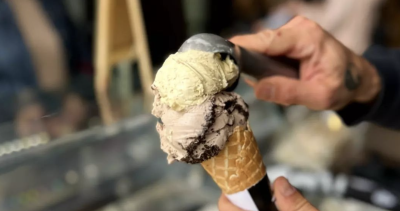Hand-woven and knotted décor make artful return to home
Local fibre artist Jolynn Vandam’s Etsy shop, Saige and Skye, had been open for less than 30 days when she received an order that effectively cleared out her entire stock. Having spotted a woven wall hanging on Pinterest in early 2015, the stay-at-home mom had picked up a kids’ weaving kit and taught herself the craft, which involves interlacing yarn on a loom to produce a piece of fabric or cloth.
She successfully created a wall hanging of her own and, a month or so later, had fashioned enough of the woolly boho-chic tapestries—nine in total—to launch Saige and Skye at the encouragement of her family and friends. A small café in Brooklyn bought all of them. “I think ever since then, I’ve been, like, ‘Huh, I’m onto something,’ ” Vandam tells the Straight by phone.
Indeed, that first batch of textural, one-off weavings soon led to hundreds more—now constructed from an array of natural fibres like cotton, merino wool, and jute—as well as a collection of plant hangers made using the art of macramé, a loose translation of the Arabic word for “fringe”, in which knotted cords or ropes produce a decorative item. (Describing herself as “pretty crafty”, Vandam is also self-taught in this realm.)
Although weaving, and macramé in particular, were all the rage in the ’70s—when the handicrafts decorated wood-panelled walls, frocks, and even hippie bedspreads in shades of cream, sickly green, and orange—the popularity of Vandam’s and other textile artists’ DIY décor demonstrates that the trend is seeing a renewal. “People love to say that my stuff is a throwback to the ’70s,” says Vandam, “but I like to believe that they’re a more modern version.”
Updating her woven tapestries for today’s more minimalist crowds, the Fort Langley–based weaver hangs them from pieces of washed-up driftwood and incorporates dreamy hues like cotton-candy pink, indigo, and soft yellow. Many of her macramé pieces, meanwhile, also hang from wood or hold handcrafted ceramic planters and even bowls of fruit. Each fibre object takes anywhere between six hours to a month to painstakingly complete.
Unlike paintings, prints, or photographs, their homey, chunky nature offers a welcome contrast to more streamlined households, which, these days, tend to favour harder edges. “It’s more of a textural art, as opposed to a traditional painting,” notes Vandam.
Ana Sousa, a local textile artist who began weaving scarves almost a decade ago and has since transitioned to woven wall hangings, sees the style’s resurgence as the result of Vancouverites rediscovering the beauty of handmade objects. “I’ve seen a spike in the last two years, where people are not only commissioning and buying the work, which is fantastic, but also wanting to learn how to make it,” says Sousa, who, like Vandam, also teaches DIY workshops around town. “And when they see a hand-woven piece on their wall, it’s like that connection for them.”
Made predominantly from fine silk, Sousa’s decorative weavings, which she markets under the name Ana Isabel Textiles, lean more delicate than bulky and often feature bunches of gold, white, and copper threads protruding from the body. The wild, overhanging fibres add an unexpected punch of texture to the hangings, creating a sort of controlled chaos on the otherwise sleek and straightforward pieces.
“It’s about bringing in those techniques [from the ’70s], but using a limited colour palette,” the East Vancouver–based artist explains, “and applying really luxury materials, rather than this chunky, itchy wool or acrylic.”
While she’s yet to delve into weaving, Charlene Dittrich’s macramé hangings modernize the retro craft, too: specifically, by anchoring the knotted art within a metal or wooden hoop so that the shape resembles a dream catcher. The self-taught artist and owner of her own brand, Fox and Flicker, also employs plenty of colour—from bold pinks and purples to ocean blues and greens—in her creations, and lately, has been experimenting with natural dyes, which she applies to cotton rope.
For Dittrich, who appears regularly at the Eastside Flea, the return of macramé fits into a larger comeback that’s led to a reprioritization of everyday ethics. “There’s such a big boho movement right now, where the ’60s and ’70s are kind of resurfacing in terms of values,” she asserts. “People are caring more about the environment and this simple way of living.”
Unlike avocado-green appliances and shag carpeting, however, you can expect woven and knotted art to stick around—not least because of its accessibility (“You only need a few supplies and there’s little to no cleanup,” notes Dittrich) and the fact that textile artists are having way too much fun with it. “There’s really only a handful of knots that you can make, but there are so many different techniques and variations that you can make with those,” Dittrich says of macramé. “It’s almost endless, really.”
“The textures, the fibres,” adds Vandam, “there are a million things you can do with a single macramé or weaving.”















Comments